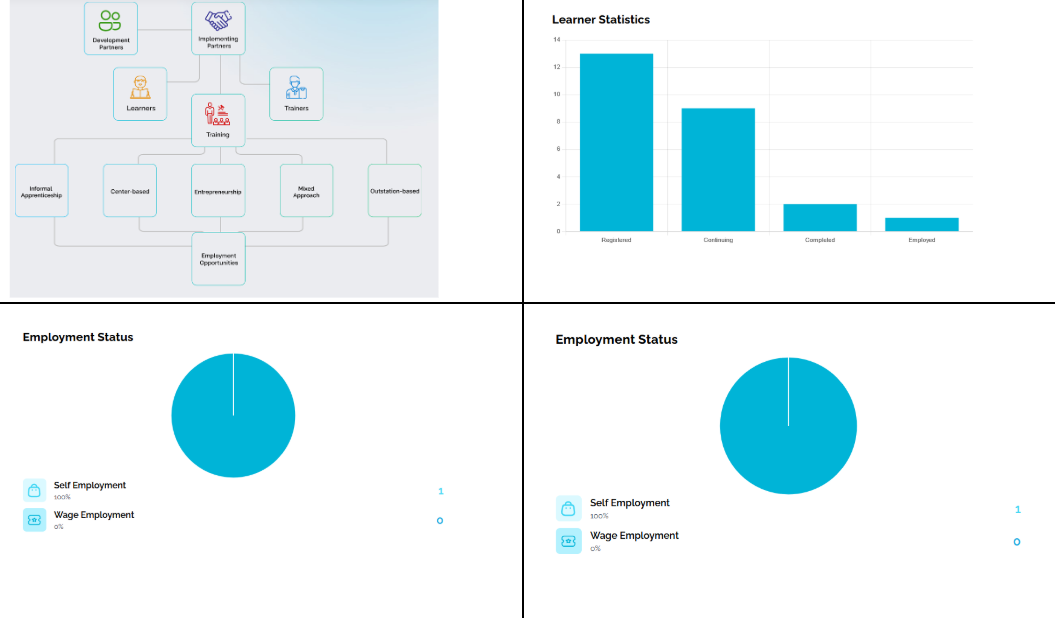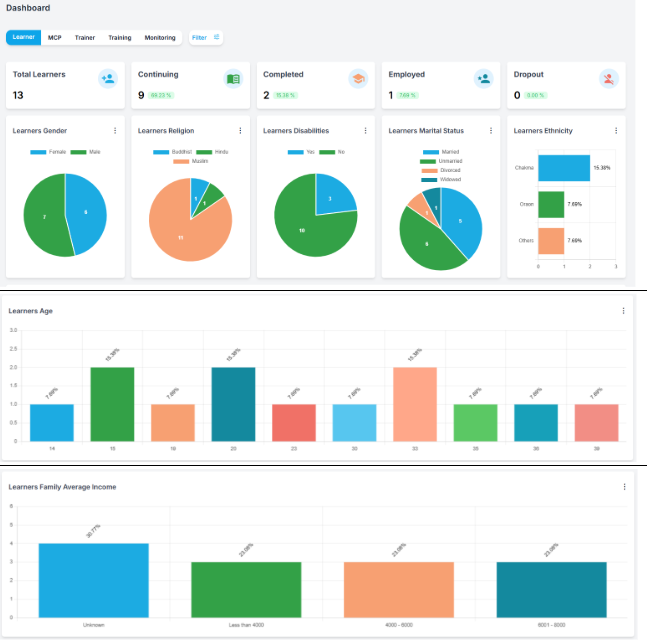Real-time monitoring platform for youth education programs
/The Need
UNICEF's Alternative Learning Programme (ALP) in Bangladesh targets 25,000 marginalized adolescents who lack access to traditional education, providing them with skills training and pathways to employment. Managing a program of this scale across urban and rural areas presented significant monitoring challenges—tracking participant attendance, skills development, training progress, and employment outcomes across multiple implementation sites and partner organizations. UNICEF needed an integrated real-time monitoring system that could centralize participant data including profiles, training status, and employment mapping across all program modules.
The challenge was to create a platform that would work reliably in rural areas with limited connectivity, enabling field staff to capture attendance, skills assessments, and progress even offline, while synchronizing data when connections became available. Additionally, UNICEF required dynamic dashboards that could provide different stakeholders—implementers, trainers, Multipurpose Community Centers (MCPs), and learning centers—with relevant views of program performance, enabling data-driven decision making and adaptive program management at scale.
The Solution
We developed an integrated real-time monitoring system that transformed how UNICEF manages the Alternative Learning Programme, providing comprehensive visibility into program operations and participant outcomes.The Centralized Participant Data module creates detailed profiles for each adolescent enrolled in the program, mapping their training status and employment journey across all program components. The system tracks which skills training modules participants have completed, their progression through the curriculum, assessment results, and eventual employment placements. This comprehensive participant view enables program managers to understand individual learner trajectories while also identifying patterns and trends across the entire cohort of 25,000 youth.The Real-Time Field Monitoring capability delivers a mobile application that captures attendance, skills assessments, and progress tracking—critically, even when offline in rural zones with limited connectivity. Field staff and trainers can record participant data during sessions without requiring internet access, with the app intelligently synchronizing information to the central database when connectivity is restored. This offline-first architecture ensures data collection continues uninterrupted regardless of infrastructure limitations, maintaining program visibility across all implementation locations.
We built a comprehensive Stakeholder Dashboard system with dynamic web views tailored to different user roles. Implementers see overall program performance and can identify implementation gaps. Trainers access participant-level data for their cohorts and track skills development progress. Multipurpose Community Centers and learning centers view operations at their locations. UNICEF program managers see aggregated national-level data with the ability to drill down to specific locations, cohorts, or individuals. These role-specific dashboards ensure each stakeholder has access to the information they need for effective decision making without being overwhelmed by irrelevant data.The Scalable Platform was architected from the ground up to support UNICEF's ambition of scaling the ALP program to reach 100,000 adolescents. The system's modular design, efficient data architecture, and cloud infrastructure ensure it can accommodate exponential growth in participants, training centers, and program complexity without performance degradation or requiring fundamental re-architecture.The platform has already achieved significant scale, successfully tracking 25,000+ marginalized youth and scaling to support 100,000+ target users, demonstrating its capacity to serve UNICEF's expanding education initiatives.
The Challenge
The primary challenge was building a system that could reliably operate across Bangladesh's diverse connectivity landscape—from urban areas with stable internet to remote rural zones with intermittent or no connectivity. The offline-first mobile application required sophisticated data synchronization logic to handle conflicts when multiple field workers collected data offline and later synchronized to the central system, ensuring data integrity while preventing loss of critical participant information.Creating centralized participant data management that could track complex, non-linear learning journeys across multiple training modules, assessment types, and employment outcomes required flexible data modeling. The system needed to accommodate different program pathways, varying skills training curricula, and diverse employment placement scenarios while maintaining data consistency and enabling meaningful analysis.Designing stakeholder dashboards that would serve the distinct needs of implementers, trainers, MCPs, learning centers, and UNICEF program managers required careful user research and iterative design.
Each stakeholder group needed different metrics, aggregation levels, and visualization types to effectively monitor their areas of responsibility. Balancing comprehensiveness with usability across these varied requirements presented significant UX challenges.Building a platform scalable enough to grow from 25,000 to 100,000+ users while maintaining real-time monitoring capabilities required thoughtful architecture decisions around database design, caching strategies, and infrastructure provisioning. The system needed to handle increasing data volumes, growing numbers of concurrent users, and expanding geographic coverage without sacrificing the real-time responsiveness essential for program management.Ensuring secure authentication and data protection for sensitive participant information—including personal profiles, education records, and employment data while enabling appropriate data sharing across implementing partners and stakeholders required sophisticated role-based access controls and security measures compliant with UNICEF's data protection standards.
The Partnership
Our collaboration with UNICEF was driven by a shared commitment to expanding educational opportunities for marginalized adolescents in Bangladesh. We worked closely with UNICEF's education specialists, program managers, and implementing partners to understand the realities of delivering alternative learning programs in challenging contexts.The partnership involved extensive field research to understand the workflows of trainers, center staff, and field monitors. We observed how data was collected in rural settings, identified the connectivity challenges that would need to be addressed, and designed offline-capable solutions that aligned with existing practices rather than requiring disruptive changes to established routines.We collaborated with different stakeholder groups to design dashboard views that genuinely served their decision-making needs. Through iterative prototyping and feedback sessions, we ensured each user role would have access to actionable insights presented in intuitive, accessible formats.
Our team managed the complex technical implementation building the Vue.js reactive frontend, PHP Laravel backend with MVC architecture and RESTful APIs, and MariaDB database with robust state management through Vuex. We implemented secure authentication protocols and architected the system for horizontal scaling to support UNICEF's growth ambitions.We also provided comprehensive training across the user hierarchy and established ongoing support mechanisms to ensure the platform continues to serve UNICEF's mission effectively as the program evolves.The measurable success—tracking 25,000+ marginalized youth and scaling to support 100,000+ target users—demonstrates how this collaborative approach created a platform that genuinely advances educational equity while providing UNICEF with the data infrastructure needed to manage, measure, and continuously improve their Alternative Learning Programme.
The Tech Stack
We built the platform using Vue.js for a reactive, responsive frontend and PHP Laravel for the backend, implementing MVC architecture and RESTful APIs for clean separation of concerns and scalability. Vue.js delivers the dynamic, interactive dashboards that different stakeholders use to monitor program performance, with Vuex providing robust state management for complex application data flows. Laravel handles the backend business logic including participant management, data synchronization, role-based access controls, and API endpoints that support both web and mobile clients.
We utilize MariaDB for reliable data management of participant profiles, training records, attendance data, and employment outcomes, with careful schema design to support complex queries and analytics. The platform features secure authentication protecting sensitive participant information, offline/online synchronization enabling real-time field monitoring even in rural areas with limited connectivity, and RESTful APIs providing the foundation for the scalable architecture—all working together to deliver centralized data management, continuous performance tracking, and stakeholder dashboards that enable UNICEF to effectively manage education programs serving tens of thousands of marginalized adolescents across Bangladesh.






